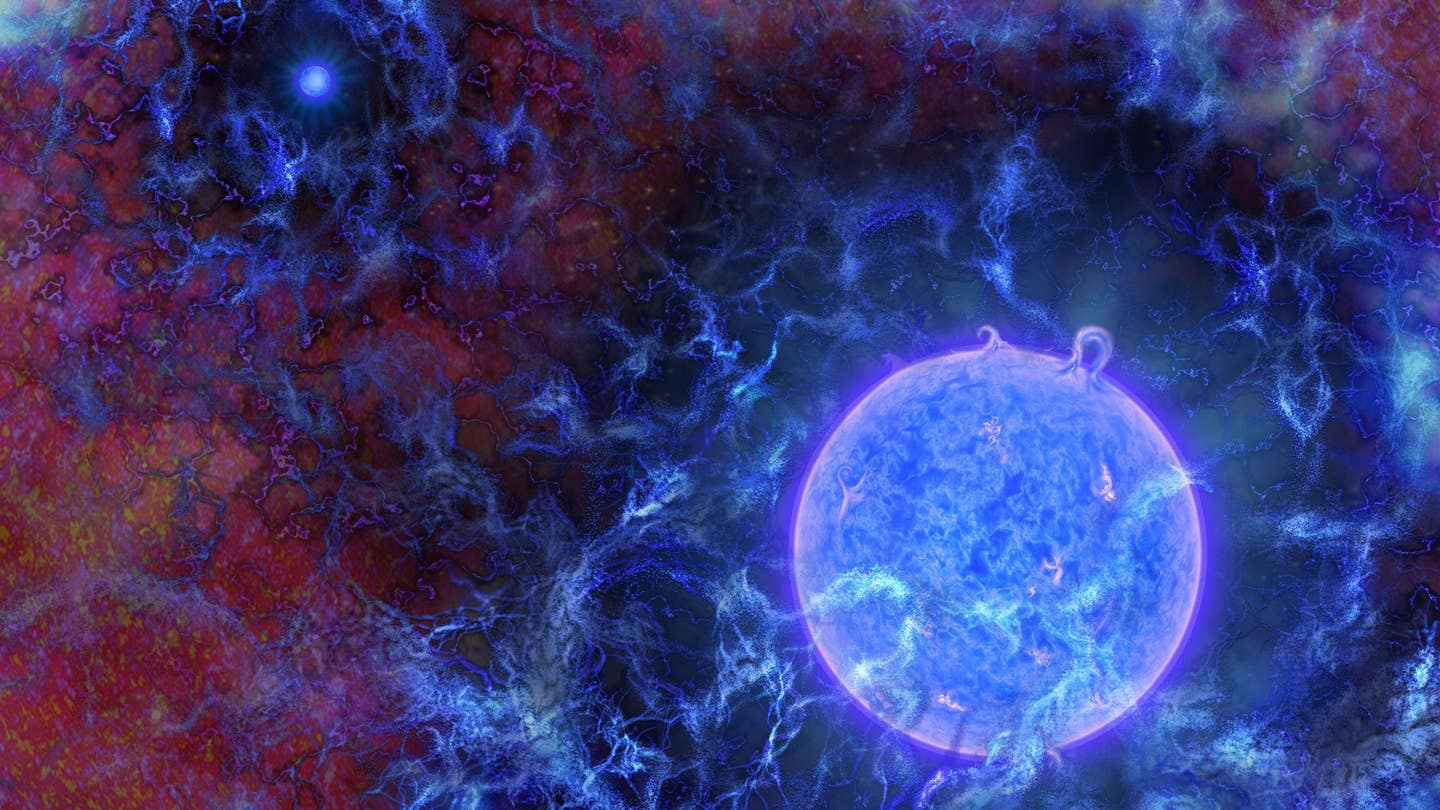The universe was already warm before the first stars lit the sky
New research shows the early Universe was warmer than expected, reshaping theories of cosmic dawn and star formation.

Artist’s rendering. Astronomers discover the universe was warmer than expected before the first stars formed. (CREDIT: N.R. Fuller / National Science Foundation)
Even before the first stars lit up the Universe, the Cosmos was not the cold place most researchers once imagined. New results suggest that the so-called cosmic "dark ages," the muted era between the Big Bang and the ignition of starlight, may not have been quite so cold after all. Instead, the gas between the galaxies seems to have been warmed by unknown sources, setting the stage for the formation of stars and galaxies.
Rethinking the Dark Ages
After the Big Bang, the Universe cooled and expanded rapidly. Hydrogen atoms formed, and the universe entered what scientists call the dark ages, an era lacking stars, galaxies, or even much light. Scientists for decades pictured this era as extremely cold, just a few degrees above absolute zero. The first stars, hundreds of millions of years later, were thought to have ended this deep freeze by heating and ionizing surrounding gas.
However, a team of scientists headed by Curtin University's International Centre for Radio Astronomy Research (ICRAR) has reversed that picture. According to their study, the intergalactic gas was warm even before the first stars actually began to shine. That would render the dark ages as more of a quiet thaw rather than a frozen silence preceding the cosmic dawn.
Listening to Hydrogen
To dig up this new picture, scientists turned to hydrogen, the Universe's most abundant element. Hydrogen atoms can absorb and emit radio waves in a process that is related to the so-called 21-centimeter line. By studying this faint signal, researchers can learn about the temperature of gas in the Universe billions of years in the past.
The scientists used data from the Murchison Widefield Array (MWA) radio telescope in the Wajarri Yamaji Country of Western Australia. Through a process of carefully comparing signals and subtracting interference from stars, galaxies, the Earth's atmosphere, and even the telescope itself, they built a clearer image of the early Universe.
Dr. Ridhima Nunhokee, the lead researcher on the first phase of the work, explained that the task involved removing other radio signals laboriously in order to reach the one that they were looking for. "From this research we've been able to develop techniques to deal with the foreground contamination and subtract the signals that we don't want, but also to understand our telescope better and arrive at a clean signal," she said.
The team combined nearly a decade of telescope observations, building the largest dataset yet of this period. That depth and quality allowed them to rule out the long-theorized existence of a cold, pristine Universe.
A Warmer Cosmic Soup
If the Universe was as cold as it should have been during the dark ages, the MWA would have detected a strong signal. That it did not means gas was already warmer than expected. "Our measurements show that it is at least heated by some amount," said Professor Cathryn Trott, lead researcher on the second phase of the work. "Not by much, but it means very cold reionisation is ruled out."
This heating, the group explains, likely had its source in high-energy X-rays from the earliest black holes or remnants of massive stars. These high-energy photons could have traveled through space, gently raising the temperature of hydrogen gas well before the first stars took over.
The result is a Universe that was not absolutely dark and cold, but already seething with unseen activity that nudged it toward the light.
Why Timing Matters
The timing of this warming is so crucial. If it had happened too soon, it could have prevented hydrogen gas from collapsing into stars. If it had happened too late, the story of cosmic dawn would be very different. Instead, the research implies a middle way, where heating occurred just in time to affect the star and galaxy formation.
This has profound implications for experiments that are now searching for the elusive "Epoch of Reionisation," the period roughly a billion years after the Big Bang when the Universe underwent a transition from opaque to transparent. Detecting this event has been a holy grail of radio astronomy.
The study shows that future telescopes, such as the Square Kilometre Array being built in Australia and South Africa, will need to incorporate this warming into their models. Otherwise, researchers might misinterpret the signals from the early universe.
The Questions Ahead
Although the findings represent a major step forward, many uncertainties remain about the mystery. What exactly caused the warming? Were black holes mainly to blame, or were exotic processes like dark matter interactions at work? And how much did this heating affect the progress of galaxy formation?
The researchers stress that more observational data are needed. The imprint of the Epoch of Reionisation is still buried in the noise, to be excavated. But with improved methods and years of painstaking data analysis, astronomers are nearer than ever to teasing it out.
Dr. Nunhokee is convinced the signal is there. "The signal is there, in there. It's a question of refining our data, and getting more data, cleaner data, to access it," she said.
Practical Applications of the Research
The discovery reshapes the prehistory of the Universe. Instead of starting from a cold standstill, the Universe may have warmed up its engines before the first stars ignited. That means, for researchers, refining simulations of galaxy, star, and black hole formation. For next-generation telescopes, it means fine-tuning their search strategies to pick up faint signals from the cosmic dawn.
More broadly, the study highlights human beings' growing ability to look backward in time. By sharpening radio telescopes and creating methods to filter out cosmic "noise," researchers are bringing us closer to answering some of the biggest questions about our origins.
The warmer dark ages are a reminder that the Universe has never been quite as fixed and predictable as we initially assumed.
Research findings are available online in The Astrophysical Journal.
Related Stories
- Astronomers use ancient radio signals to detect the universe's first stars
- Black hole stars: Giant stars may hide black holes at their core
- A wormhole from another universe? Scientists revisit the puzzling black hole GW190521
Like these kind of feel good stories? Get The Brighter Side of News' newsletter.
Joseph Shavit
Science News Writer, Editor-At-Large and Publisher
Joseph Shavit, based in Los Angeles, is a seasoned science journalist, editor and co-founder of The Brighter Side of News, where he transforms complex discoveries into clear, engaging stories for general readers. With experience at major media groups like Times Mirror and Tribune, he writes with both authority and curiosity. His work spans astronomy, physics, quantum mechanics, climate change, artificial intelligence, health, and medicine. Known for linking breakthroughs to real-world markets, he highlights how research transitions into products and industries that shape daily life.



